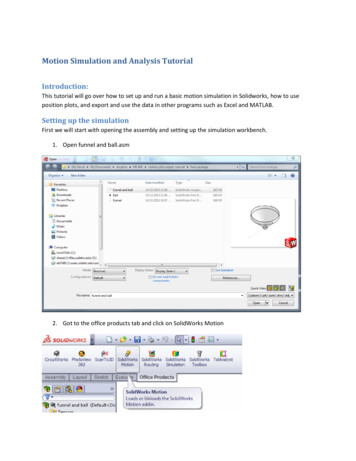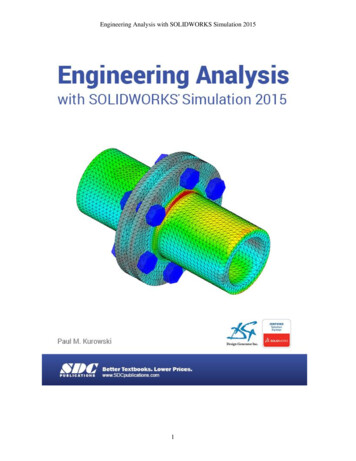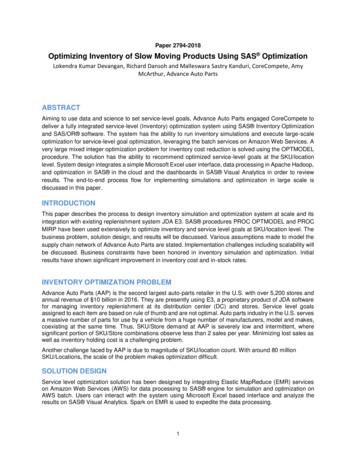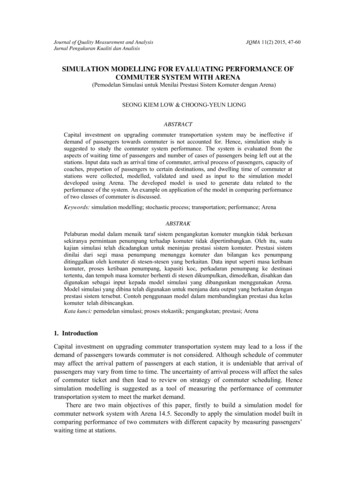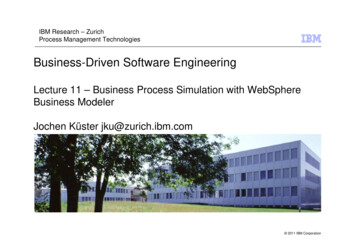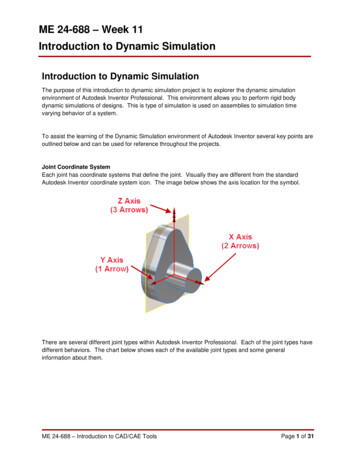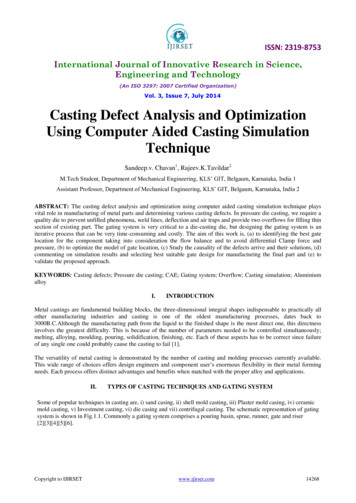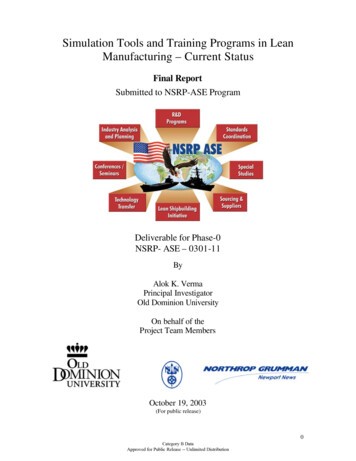
Transcription
Simulation Tools and Training Programs in LeanManufacturing – Current StatusFinal ReportSubmitted to NSRP-ASE ProgramDeliverable for Phase-0NSRP- ASE – 0301-11ByAlok K. VermaPrincipal InvestigatorOld Dominion UniversityOn behalf of theProject Team MembersOctober 19, 2003(For public release)0Category B DataApproved for Public Release -- Unlimited Distribution
Table of ContentsTopicPage No.1. Executive Summary022. Introduction033. Background Information044. Goal of the study055. Survey Methodology056. Organizations Surveyed077. Lean Training Programs Currently Availablea. Lean Training Programs Currently Available to Industryb. Lean Training Programs offered by Educational Institutions0707088.Simulation Tools Currently Used089. Description of Simulation Tools0910. Identification of Needs in Shipbuilding & Repair Industry2111. Proposed Areas for Simulation Activities2212. Summary2313. References2414. Appendixa. Training Survey Form – Ib. Simulation Survey Form – IIc. Need Identification Survey Form – IIId. Survey Results Spread Sheete. Simulation Tools and Current Usersf. Identification of Simulation Needs262629313346491Category B DataApproved for Public Release -- Unlimited Distribution
1. Executive SummaryThis report presents the current state of Lean training programs and their use inshipbuilding/repair industry. This information has been presented in a spreadsheet(Appendix-d) for three types of organizations, shipyards, consulting firms andeducational institutions. The report also looks at simulation tools currently used, andpresents a case for the need of new simulation tools for Lean enterprise implementation.Five areas specifically related to shipbuilding and repair industry are identified basedupon the feedback from Lean training coordinators and managers from shipyards.The response rate for the first survey was 56%. Results indicate that majority oforganizations use Lean training programs developed by NIST. These training programscover a variety of Lean principles like 5S, setup reduction, value stream mapping and areusually one day long. A few of these training programs include simulation activities.In addition to the above programs developed by NIST, several universities havedeveloped their own Lean training programs. These range in length from one day to fivedays. They cover a wide variety of topics including management techniques, six sigmaand supply chain management. A few universities offer certificate programs in Leanmanufacturing ranging in length from 5 to 10 days.Consulting firms use a variety of training programs including variations of thosedeveloped by NIST and some programs that were developed in-house. In addition to inclass training, some consulting firms offer in-plant Lean implementation along withtraining. Most of the in-class training programs are one day long. Those involving inplant implementation can range in length from 2 to 25 days.Our survey has identified a total of 17 simulation activities currently used invarious Lean training programs. Among these the simulation activities developed byNIST (Buzz Electronics, 5S & Set-up Reduction) are most commonly used. The matrix inAppendix-e shows the use of these tools by various organizations and the Lean principlesthey illustrate. A majority of these simulation activities simulate production operationswithin an organization as indicated in Figure-1.None of these simulation activities are designed to address issues related to Leanenterprise implementation like ship design, ship repair, contracting and acquisition,scheduling and enterprise resource planning. The lean enterprise value simulation andBeer game developed at MIT are the only activities that even try to tackle the issue ofsupply chain integration. In addition, all the simulation activities available are designedfor the high-volume and low-variety manufacturing environment. Results of the surveyestablish the need for simulation activities to complement the effort of shipyards inbecoming Lean enterprises. The topics identified for simulation development cover widerissues and will provide realistic training tools. Figure-2 shows the issues covered by theproposed simulation activities. The proposed tools will also complement the ExtendedLean Enterprise project funded by NSRP this year.2Category B DataApproved for Public Release -- Unlimited Distribution
Figure 1. Areas Addressed by Current Simulation ToolsFigure 2. Areas Addressed by Proposed Simulation Tools2. IntroductionLEAN is a philosophy adopted by manufacturers all around the world to reducewaste and improve productivity. It focuses on changing the work culture within anorganization and across the supply chain. Lean philosophy’s impressive performance inreducing costs of production is at the heart of the growing challenges faced by the USshipbuilding and repair industry. Today, transforming into a Lean enterprise is theultimate goal of many shipyards.Simulation is an effective teaching tool that makes complex concepts easy tograsp. This is mainly due to the active participation of the people involved in a workplaceenvironment that simulates variability. According to the Encyclopedia of EducationalTechnology, “Simulation-based learning involves the placement of a student into arealistic scenario or situation. The student is then responsible for any changes that occuras a result of their decisions.”3Category B DataApproved for Public Release -- Unlimited Distribution
Though simulations are effective, the simulation models which are used currently,lack some key elements such as,Ø Emphasis is laid on manufacturing operations only. Supply chain and businessoperations are often ignored, both of which are critical factors in the success ofan enterprise. A failure or delay in either of these areas can cause reducedproductivity and increased waste.Ø Lack of real shipyard applications. The results of the survey indicate that most ofthe existing simulation tools include applications from electronics andmanufacturing industries. The proposed simulation activities will be based onapplications pertinent to the shipbuilding industry.Ø Limited design and scope of simulation exercises. Most simulations are based onlarge volume discrete event manufacturing where products are manufactured asthey move through the system. They do not apply to the low volume /high varietymanufacturing environments found in a shipyard, where the products remainstationary and parts and services are delivered to the site. Low volume /highvariety will be addressed in the proposed simulation activities.The simulation activities developed under this project will utilize Lean tools to teachand demonstrate the effectiveness of Lean principles along a Value Stream. Simulationactivities will incorporate the animation feature of discrete event simulation software likePro-Model, to demonstrate the effectiveness of lean principles. The simulation activitieswill address supply chain, business operations, real shipyard applications, stationarymanufacturing and low volume /high variety.This report first examines the existing Lean simulations found in the industry andtheir applications. It includes the results of extensive survey of shipyards andidentification of five critical areas that require simulation development. After anextensive survey of the shipyards, educational institutions and consulting firms, fivecritical areas are selected and presented.3. Background InformationOld Dominion University and Northrop Grumman Newport News jointlysubmitted a proposal under the NSRP-ASE program in May 2003 to develop secondgeneration simulation tools to complement existing lean training programs used by theshipbuilding and repair industry. As a condition of full award for this project proposedunder NSRP Research Announcement 3, the Executive Control Board (ECB) directed theproject team to perform a Phase 0 within 60 days to "conduct a survey of existing Leanshipbuilding/ship repair training programs and simulation tools to determine the extent towhich they overlap or complement those in this project. The survey shall include, but isnot necessarily limited to: investigation of lean training and simulations developed and/orconducted under the ongoing NSRP Lean Enterprise Model project; investigation of leantraining and/or simulations developed under the ONR project involving NorthropGrumman Ship Systems; and consultation with members of the NSRP LeanImplementers Group. The Executive Control Board of the NSRP will review the Phase 04Category B DataApproved for Public Release -- Unlimited Distribution
results and their approval will be required prior to commencement of Phase 1, which willinclude the remainder of the proposed work."This report is the deliverable for Phase-0 as directed above by ECB.4. Goal of the StudyBased upon the recommendations of ECB, the project has four primary goals asdescribed below:Ø Survey of the existing Lean Training Programs.Ø Study of existing Lean Simulation Tools used in Lean Training ProgramsØ Identification of needs in shipbuilding and repair industry.Ø Identification of five areas in which simulation tools and associated training programswill be developed during subsequent phases.After the analysis of the existing lean training programs and simulation toolswhich are used in various shipbuilding/ship repair companies, consulting agencies, anduniversities, it was found that simulation models that are used in today’s Lean trainingprograms do not address the issues related to a Lean Enterprise. Most of these exercisesfocus on manufacturing operations only and ignore the Supply chain and businessoperations. This project focuses on incorporating these important elements into trainingprograms. The second area of concern with existing training programs is lack of realshipyard application in simulation models currently avialiable. The third area of concerndeals with Design and scope of simulation exercises. Shipbuilding and repair industryrepresents a low volume/high variety-manufacturing environment; these twocharacteristics require that simulation exercises that we propose to develop represent theflow of the entity and the variety of components moving through the system. Byidentifying the needs of shipbuilding/repair industry, we will identify five areas, whichare critical for the development of simulation exercises and associated training programs.5. Survey MethodologyFigure-3 represents the methodology of the survey. Initially an Internet search ofvarious Lean training program used in the industry (ship building/ship repair), consultingagencies and universities was conducted. A survey form (Form-I, Appendix-a) wasprepared to collect data regarding the Lean training programs and was e-mailed to theidentified organizations. Follow-up phone calls to the survey recipients were made andtheir responses were compiled in a spreadsheet (Appendix-d). A second survey form(Form-II, Appendix-b) was prepared to collect detailed information about types ofsimulation tools available and their usage. Results of this survey are compiled in the formof a table in Appendix-e. A third survey form (Form-III, Appendix-c) was prepared toidentify five critical areas in shipbuilding industry for the development of simulationtools. This form was sent to Lean training coordinators and managers in shipbuilding andship repair industries with eleven possible areas. Based upon the responses received, topfive areas were selected for the development of simulation activities and associated5Category B DataApproved for Public Release -- Unlimited Distribution
training programs. Figure-3 below illustrates the sequence of activities within surveymethodology.INTERNET SEARCH OF LEAN TRAININGPROGRAMS PRESENTLY AVAILABLEPREPARE SURVEY FORM-1 FOR LEANTRAINING.MAIL SURVEY FORM-1 TO SHIPBUILDING/SHIPREPAIR COMPANIES,CONSULTING AGENCIES, AND UNIVERSITIESFOLLOW UP WITH PHONECALLSANALYSIS OF FEEDBACKIDENTIFIED TRAINING PROGRAMSWHICH USE SIMULATION TOOLSPREPARED & E-MAILED SIMULATION SURVEY FORM-2 TO SHIPBULDING/SHIP REPAIR COMPANIES, CONSULTING AGENCIES, AND UNIVERSITIESANALYSIS OF FEEDBACKPREPARE SURVEY FORM-3 AND E-MAILED TO IDENTIFY FIVEAREAS WHERE SIMUALTION CAN BE APPLIEDANALYSIS OF FEEDBACK FROMSHIPYARDS.IDENTIFY FIVE AREAS WHERESIMULATION EXCERCISES CAN BE APPLIEDFigure 3. Survey Methodology Process Flow6Category B DataApproved for Public Release -- Unlimited Distribution
6. Organizations SurveyedForty-eight consulting firms were contacted and asked to complete survey formsgiving details about their Lean training programs and simulations. Twenty-five haveresponded to date. Those to be contacted were identified in a number of ways. A list ofLean consultants was provided by the Lean Training Administer at Northrop GrummanShipyard and others were identified through a search on the internet and through marketresearch and referrals to learn about training companies and providers of Lean trainingthat were thought to offer simulations. Surveys were emailed if contact information wasavailable and inquiries were sent to request contact information if none was provided.Follow up calls were made to gather necessary information about Lean simulation toolsthat currently exist and to learn of other known lean providers. Twelve members of theLean Implementers Group representing U.S. shipyards were also contacted because theyuse or have created Lean training of some type. Follow up calls were made to ensure thatthe information was sent to the appropriate contact and to request that it be completedand submitted. Six have responded by submitting completed survey forms.Out of the 22 Educational Institutions surveyed 17 are part of the LeanAerospace Initiative (LAI) Educational Network Program, the remaining 5 namelyNorthwest Arkansas Community College (NWACC), Red River College, North CarolinaState University (NCSU), Pueblo Community College and Auburn University were foundthrough internet search for Lean Training Programs offered by Educational Institutions.Survey forms were sent to these 22 Educational Institutions, asking them for detailsregarding courses taught in Lean Manufacturing, Simulation activities used fortraining/courses, need for any specific simulation tools for training that they think is needof the hour. Till date 10 Educational Institutions have responded.7. Lean Training Programs Currently Availablea. Lean Training Programs Currently Available to IndustryResearch revealed that some Lean training programs conducted by consultantsconsist mainly of traditional classroom lecture to teach Lean concepts which are appliedto case studies or to actual shop or office floor process improvement efforts. They oftenoffer on-site “hands on” training to teach participants how to apply Lean techniques forachieving quick changeovers, eliminating wastes, 5S, cell manufacturing, and improvingflow and visual controls to their own processes. There are also numerous coursesavailable on CD’s for workforce training. Videos, books, and manuals can be purchasedand are often used to teach Lean concepts. Some consultants use computer applicationsto teach and support process improvement efforts. The consultants who incorporate livesimulation exercises into their training programs use them to demonstrate pull versuspush systems, cellular manufacturing, value stream mapping, set-up reduction, 5S andcontinuous improvement.For the purpose of this study, the term “simulation” will refer to livesimulation activities in which students participate in role plays in environments thatsimulate actual manufacturing processes. The term will not be used to refer to computerbased simulations, which involve engineers writing equations, and using computers tonumerically solve those equations, unless the term “computer simulation” is used.7Category B DataApproved for Public Release -- Unlimited Distribution
In the shipbuilding industry, most Naval Shipyards use the same trainingmaterials including the 5-week Lean Sigma College and Lean Workshops. Othershipbuilders use Buzz Electronics, a lego exercise, or a paper airplane game.b. Lean Training Programs Currently Offered by Educational InstitutionsThere are many training programs/courses currently available throughEducational Institutions in Lean Manufacturing, many of which are provided incollaboration with MEP.Around 22 Educational Institutions were surveyed and it was found that almost65% of them give training in Lean 101/Lean Manufacturing Overview. This programhelps one learn how lean improves quality, reduces cycle time, improves deliveryperformance and reduces WIP.47% of the Educational Institutions provide training in Value Stream Mapping, inwhich flow of product is mapped and work process streamlined, from the results, whichhelps in cutting lead-time and operating cost. 53% of the Educational Institutions havetraining programs/courses in 5S wherein participants are taught how implementing 5Shelps in improving workplace organization and standardization. 35% of the universitiesalso provide training in Setup Reduction, which is based on the principle of SingleMinute Exchange of Dies (SMED) to dramatically reduce or eliminate changeover time.24% of the universities provide training programs/course in TPM, Pull/ Kanban andKaizen. There are few universities, which also provide training in supplier chainmanagement and integration and mistake proofing.8. Simulation Tools Currently UsedSurvey results indicate that for the consultants who have responded, over half ofthem use a factory simulation using a type of plastic cube (legos or something similar), torepresent assembling a product on a factory floor and moving it from one station to thenext. Four companies developed simulations that simulate manufacturing processesusing larger equipment. One involves processing golf balls, one boxes, one a metalstamping machine, and one a printing press. Some consultants use a variation of the BeerGame developed at MIT, and some use TimeWise 101 and 102 in their training.In the shipbuilding industry, results show that Lean training simulations consistof variations of MEP exercises, Six Sigma programs, NIST-MEP 5 S training, the clockexercise developed by TimeWise, or Buzz Electronics with a circuit board. With theexception of the paper airplane game the simulations were not developed in-house.Most of the consultants contacted that offer training and live simulation toolshave developed them for mass production and build-to-stock or build-to-order inmanufacturing environments rather than for situations with low volume, high mix in anengineer-to-order environment like shipbuilding and repair.Three consultants, whohave extensive training experience in shipbuilding and aerospace industries,acknowledged that they have unsuccessfully looked for years for applicable simulations,and that they do not currently exist to replicate the unique set of challenges thatshipbuilders face. One explained that he tried to create a simulation of a small factory8Category B DataApproved for Public Release -- Unlimited Distribution
with a large mix of products and random orders, but that it became too complicated andwas abandoned. Some consultants use a variation of one of the factory simulationscurrently on the market to teach basic Lean techniques, but none are specifically designedto be used in the shipbuilding industry.Most of the Educational Institutions surveyed are part of the Lean AerospaceInitiative (LAI) Educational Network program. Survey forms were sent to more than 20Educational Institutions, asking them for details regarding courses taught in LeanManufacturing, Simulation activities used for training/courses and need for any specificsimulation tools for training. Emails were sent in the third week of September. The initialemails were followed by follow-up phone calls. To date 10 Educational Institutions haveresponded.Most of the universities contacted use training and simulation tools developed byNIST-MEP, which simulates high volume/ low variety manufacturing environment.Very few universities have developed their own simulation tools but they too simulatehigh volume/ low variety manufacturing environment. Few of the contacted universitiesdo not use any simulations for training while few universities use discrete event computersimulations.One university acknowledged that they require simulation tools that usessoftware for training value stream mapping while another university needs simulationtools that can be used for training lean concepts such as one piece flow, cellular layout,supply chain and lean enterprise.9. Description of Simulation ToolsTimeWise Simulation:The TimeWise Simulation game is designed by MEP-MSI (ManufacturingExtension Partnership, Management Services, Inc.) a private, nonprofit managementconsulting organization for small and medium sized enterprises. In the TimeWisesimulation, participants work as a group to run TimeWise, which assembles two products– a blue clock and a black clock.In this simulation supplier supplies the raw material to warehouse. From warehouse(kitting area) material handlers supply the material to various workstations. There are fiveworkstations as Face assembly, back assembly, clock assembly, hand assembly, clockassembly, and inspection and rework. Flow of material and is shown in figure-4. Inaddition to those who are directly involved in assembling clocks, TimeWise employs anumber of support personnel – in positions ranging from the supervisor to warehouseclerks.There are three sessions of simulation in first round of TimeWIse; later roundswill explore the impact of redesigns on the company and process. Each session ofsimulation is followed by a discussion. For each session of play, participants will assumea different responsibility within the company. By playing different roles, participantswill be able to observe the process from different perspectives and obtain new insight asto how the process might be improved.9Category B DataApproved for Public Release -- Unlimited Distribution
MEPMSI offers following Lean Training Programs using Time clock simulation ,Time Wise -- Lean 101 Principles of Lean ManufacturingTime Wise -- Lean 101 Executive OverviewTime Wise -- Principles of Lean Manufacturing for Job ShopsTime Wise -- Lean Fundamentals for Shipyards.Time Wise -- Principles of Lean Manufacturing for Front Office ApplicationsSuppliersProduction SchedulerMaterial HandlingSupervisorTool Crib AttendantIndustrial EngineersWarehouse ClerkSales lyClockAssemblyHandAssemblyInspection &Rew orkCustomersFigure 4. Flowchart for TimeWise SimulationPipe Factory Simulation:University of Dayton has developed this simulation exercise for Kaizen training.In this simulation exercise participants work in teams to learn kaizen concepts.During the first half of the training program participants take part in five simulationexercises and in the second half they learn the mechanics of simulations from the firsthalf.In this simulation four pipe sub assemblies (A,B,C,D) are assembled together. Inall there are six workstations: one each for four sub assemblies, one for final assembly &one for inspection & repair. The First simulation is a traditional factory simulation.During Simulation 1, participants will perform subassembly operations in the “isolatedislands” of traditional manufacturing environment and observe all its inherent wastes.The second simulation simulates push production. The third simulation is again a10Category B DataApproved for Public Release -- Unlimited Distribution
simulation of push production but in this simulation time observations and kaizen formsare included. The fourth simulation simulates one-piece flow. The fifth simulation isoptional one and it is further refinement of one-piece flow. In simulations 2,3,4,5 leantools are applied progressively to eliminate the waste.A performance matrix is used for work-in-progress inventory (WIP), number ofparts rejected, production output, cycle time, number of operators required, floor space,and parts travel distance. Teams also apply a financial model to calculate profit and lossfor each simulation.Lean Sim Machine:The Donnelly Corporation developed this simulation. The Lean Sim Machine is ahands-on simulation that is used to introduce core principles related to leanmanufacturing and continuous improvement. The Lean Sim Machine simulates thedynamics of a factory that produces automotive components. Production processessimulated include injection molding, heat-treating, painting, assembling, conveying, andcustomer order fulfillment. The product variations requested from customers require die changes.In the Lean Sim Machine simulation, participants become employees of acompany “Traditional Manufacturing Company” for the duration of the simulation. Thecompany makes “metal linkages” for the automotive industry. The metal linkage consistsof five components – 2 bolts, 2 nuts, and one flat bar. Three types of linkages - silver,black and gold are produced by the company. Figure-5 shows all three machines used inthe simulation. The set up includes:Manufacturing plant:Nut manufacturing (simulates injection molding)Paint Curing (includes conveyor belt)Bolt hardening (simulates heat treatment)Final assembly (simulates piecework assembly)Distribution Center:Warehouse inventory and finished goods ships products to customers.There are 5 operators and one material handler. Remaining participants areobservers. Duration of each simulation activity is five minutes. The first round is atraditional manufacturing simulation. Different lean concepts are applied in the followingrounds.The performance metrics used are quality issues, WIP inventory, andeffectiveness of labor and space utilization. The equipments used for simulation are:3 Finely-crafted oak machines that simulate typical manufacturing processes: a paint line (includes paint racks, paint booth, conveyor system and ramps) an injection molding machine (complete with 3 dies to simulate die changes) a heat-treating machine pallets, finished good racks, nuts,bolts, linkages heavy-duty locking storage box11Category B DataApproved for Public Release -- Unlimited Distribution
Figure 5. Models Used in Lean Sim Machine SimulationLean Enterprise Value Simulation Game (Aircraft Simulation):Lean Aerospace Initiative has developed this simulation exercise. This is asimulation of a complex aerospace enterprise. Tables of 4-6 people represent major silosas manufacturing, supplier network, and product development. Each person has his ownfacility (manufacturing plant or individual 1st or 2nd tier supplier or product developmentfunction.) The simulation uses Legos to build aircraft. The manufacturing table is shownin figure-6.Manufacturing Table2Plant A WingsFinal AssemblyManufacturingTable11Plant B Tailweb.mit.edu/leanPlant C Fuselage Massachusetts Institute of Technology McManus- 0326034Figure 6. Manufacturing Tables in Aircraft Simulation12Category B DataApproved for Public Release -- Unlimited Distribution
First work processes at the manufacturing table will receive all necessaryparts/assemblies from attached facilities or suppliers and complete assembly. The secondprocess is to rework the assembly to meet specifications.Beer Game Simulation:The Beer game simulation was developed at MIT in the 1960’s to clarify theadvantages of taking an integrated approach to managing the supply chain (i.e. todemonstrate the value of sharing information across the various supply chaincomponents). The Beer game simulates the supply chain that exists between a beermanufacturer, distributor, wholesaler, and retailer.The participants are assigned to a table. Everyone seated at each individual tablewill be considered a team and will compete against other table teams. The game canaccommodate up to 9 players per table. The four channel partners that comprise thesupply chain are:RetailerWholesalerDistributorFactoryFigure-7 shows Beer game board. A participant’s primary goal is to fillcustomer’s orders in full while keeping his inventory cost to a minimum and avoidingstock-outs. During the game participants inventory levels are tracked. There are penaltiesfor carrying too much inventory and penalties for stock-outs in the form of “cost-of-lostsales.”Figure 7. Beer Game board, showing initial conditions.The Web Based Beer Game Simulation:This simulation is based on the manual beer game simulation described above. Inthis exercise, the participants will be faced with the following scenario: Consider asimplified beer supply chain, consisting of a single retailer, a single wholesaler whichsupplies the retailer, a single distributor which supplies the wholesaler, and a singlefactory with unlimited raw materials which makes (brews) the beer and supplies thedistributor. Each component in the supply chain has unlimited storage capacity, and thereis a fixed supply lead time and order delay time between each component. Each week,13Category B DataApproved for Public Release -- Unlimited Distribution
each component in the supply chain tries to meet the demand of the downstreamcomponent.Any orders, which cannot be met, are recorded as backorders, and are met assoon as possible. No orders will be ignored, and all orders must eventually be met. Ateach period, each component in the supply chain is charged a 1.00 shortage cost perbackordered item. Also, at each period, each location is charged .50 inventory holdingcost per inventory item that it owns. Each component owns the inventory at that facility.In addition, the wholesaler owns inventory in transit to the retailer; the distributor ownsinventory in transit to the wholesaler; the factory owns both items being manufacturedand items in transit to the distributor.Each supply chain member orders some amount from its upstream supplier. Ittakes one week for this order to arrive at the suppl
educational institutions. The report also looks at simulation tools currently used, and presents a case for the need of new simulation tools for Lean enterprise implementation. Five areas specifically related to shipbuilding and repair industry are identified based upon the feedback from Lean


